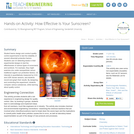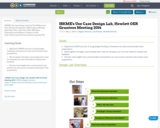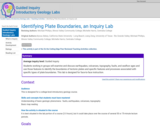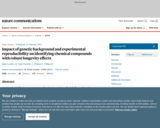
Contains cover sheet.
- Subject:
- Elementary Education
- Literature
- Material Type:
- Lesson Plan
- Author:
- Michelle Robinson
- Date Added:
- 07/08/2019

Contains cover sheet.

This guide provides information and resources to help educators find openly-licensed texts.

In this section, you and your team will engage in a Landscape Analysis to uncover key structures and supports that can guide your work to support Accessibility in OER. You may or may not answer all of these questions, but this is an offering.

A lesson for a HS Adaptive PE class review the skills for basketball. It would be a great lead up activity a few days before introducing a live game to your class.

An online brain dominance inventory provides students with information on their brain dominance and information processing style. This relates to perception and learning styles.

The Overall Aim of the Text
The text intends to communicate information about holistic nursing and healing environments. The holistic nursing knowledge and skill base are vast. There are many areas of holistic health and nursing! Holistic nurses should acknowledge the wide breadth of content by using multiple resources to advance expertise as a holistic nurse.
Main Goals of the Text
Provide information about holistic nursing, including healing environments.
Provide information about holistic nursing roles, nurse practice acts, scope, standards, and ethics.
Deliver nursing research and evidence-based practice content specific for holistic nursing practice.
Relate key areas in holistic nursing in preparation for holistic nursing practice or sitting the holistic nurse certification examination. This is one source, and holistic nurses are encouraged to also access other sources. The content knowledge of holistic nursing is quite vast and requires extensive study for national board certification. Additional sources are found at the end of each chapter in the textbook.

Students are introduced to a challenge question. Towards answering the question, they generate ideas for what they need to know about medicines and how they move through our bodies, watch a few short videos to gain multiple perspectives, and then learn lecture material to obtain a basic understanding of how antibiotics kill bacteria in the human body. They learn why different forms of medicine (pill, liquid or shot) get into the blood stream at different speeds.

Student teams design and conduct quality-control experiments to test the reliability of several ultraviolet protection factors. Students use UV-detecting beads in their experimental designs to test the effectiveness of various types of sunscreens and sunblock. For example, they might examine zinc oxide nanoparticles versus traditional organic sun protection factors. UV intensity is quantitatively measured by UVA and UVB Vernier sensors, and students record and graph their results. By designing and conducting this experiment, students compare various substances, while learning about quality control.

Canvas Commons course shells for A&P sequence.
BI 231: One of three courses within the human anatomy and physiology sequence that need not be taken in order. This course provides students with the opportunity to study the structure and function of the human body from a systematic perspective, while emphasizing homeostasis, organ system interaction, and complementarity of structure and function. Specific topics include: the integumentary, skeletal, cardiovascular and lymphatic systems. Laboratory sessions include dissecting animal specimens, conducting physiological experiments, examining case studies, using the compound microscope, and studying anatomical models.
BI 232: One of three courses within the human anatomy and physiology sequence that need not be taken in order. This course provides students with the opportunity to study the structure and function of the human body from a systematic perspective, while emphasizing homeostasis, organ system interaction, and complementarity of structure and function. Specific topics include: the muscular and nervous systems, special senses, and the endocrine system. Laboratory sessions include dissecting animal specimens, conducting physiological experiments, examining case studies,using the compound microscope, and studying anatomical models.
BI 233: One of three courses within the human anatomy and physiology sequence that need not be taken in order. This course provides students with the opportunity to study the structure and function of the human body from a systematic perspective, while emphasizing homeostasis, organ system interaction, and complementarity of structure and function. Specific topics include: the respiratory, digestive, urinary, and reproductive systems. Laboratory sessions include dissecting animal specimens, conducting physiological experiments, examining case studies, using the compound microscope, and studying anatomical models.

Human Genetics Open Pedagogy Lesson Plan
BI 222 Human Genetics
Description
Presents the fundamentals of human genetics. Includes physical basis of inheritance, the mechanics of inheritance, probability, sex chromosomal abnormalities, autosomal anomalies, gene structure and function, molecular genetics, behavioral genetics, twinning and contemporary issues in human genetics.

This is an information sheet on the species, Hylocichla mustelina, provided by the University of Michigan Museum of Zoology.

This lesson provides an overview and serves as an introduction of the exteneded essay (EE). The EE is one component of the International Baccalaureate® (IB) Diploma Programme (DP) core, the and is mandatory for all students.Read about the extended essay in greater detail.

In this section, you and your team will engage in a Landscape Analysis to uncover key structures and supports that can guide your work to support Accessibility in OER. You may or may not answer all of these questions, but this is an offering.

ISKME's Use Case Design Lab from The William and Flora Hewlett Foundation’s OER Grantees Meeting, April 22nd, 2014 - April 24th, 2014: OER Value Proposition and Evidence of Impact in 2014
http://iskme.org/events/oer-grantee-meeting-2014

Average inquiry level: Guided inquiry
Students working in groups will examine and discuss earthquakes, volcanoes, topography, faults, and seafloor ages and use those features to identify the boundaries of tectonic plates and specific features and processes associated with specific types of plate boundaries. This lab is designed for face-to-face instruction.
(Note: this resource was added to OER Commons as part of a batch upload of over 2,200 records. If you notice an issue with the quality of the metadata, please let us know by using the 'report' button and we will flag it for consideration.)

Limiting the debilitating consequences of ageing is a major medical challenge of our time. Robust pharmacological interventions that promote healthy ageing across diverse genetic backgrounds may engage conserved longevity pathways. Here we report results from the Caenorhabditis Intervention Testing Program in assessing longevity variation across 22 Caenorhabditis strains spanning 3 species, using multiple replicates collected across three independent laboratories. Reproducibility between test sites is high, whereas individual trial reproducibility is relatively low. Of ten pro-longevity chemicals tested, six significantly extend lifespan in at least one strain. Three reported dietary restriction mimetics are mainly effective across C. elegans strains, indicating species and strain-specific responses. In contrast, the amyloid dye ThioflavinT is both potent and robust across the strains. Our results highlight promising pharmacological leads and demonstrate the importance of assessing lifespans of discrete cohorts across repeat studies to capture biological variation in the search for reproducible ageing interventions.

Research/Informational lesson for 4th graders about Vertebrates.

The Inquiry-Oriented Linear Algebra (IOLA) project focuses on developing student materials composed of challenging and coherent task sequences that facilitate an inquiry-oriented approach to the teaching and learning of linear algebra. The project has also developed instructional support materials to help instructors implement the IOLA tasks in their classrooms.
How to cite IOLA materials: Wawro, M., Zandieh, M., Rasmussen, C., & Andrews-Larson, C. (2013). Inquiry oriented linear algebra: Course materials. Available at http://iola.math.vt.edu. This work is licensed under a Creative Commons Attribution-NonCommercial-ShareAlike 4.0 International License.
This material is based upon work supported by the National Science Foundation under grant numbers DUE-1245673/1245796/1246083. Any opinions, findings, and conclusions or recommendations expressed in this material are those of the author(s) and do not necessarily reflect the views of the National Science Foundation.

This textbook provides the novice learner with a foundational understanding of Canada’s 2019 Food Guide and Food Labelling. It highlights important considerations for future health professionals seeking to adopt the new food guide into their practice, including strategies towards healthy eating. This open textbook underscores a relational inquiry approach to inform discussions with clients about nutrition and healthy eating.

Word Count: 7088
(Note: This resource's metadata has been created automatically by reformatting and/or combining the information that the author initially provided as part of a bulk import process.)